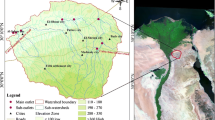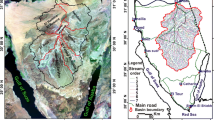Abstract
This main objective of this study is flash flood susceptibility modeling using geo-morphometric and hydrological approaches in Panjkora Basin, Eastern Hindu Kush, Pakistan. In the study region, flash flood is one of the horrific and recurrent hydro-meteorological disasters causing damages to human life, their properties, and infrastructure. Watershed modeling approach is implemented to delineate Panjkora Basin, its sub-basins, and extract drainage network by utilizing Advance Space borne Thermal Emission and Reflection Radiometer Global Digital Elevation Model as an input data in geographic information system environment. A total of 30 sub-basins were delineated using threshold of 25 km2. The geo-morphometric parameters of each sub-basin were computed by applying Hortonian, Schumm, and Strahler Geo-morphological laws. The value of each parameter was normalized and aggregated into geo-morphometric ranking number depicting the degree of flash flood susceptibility. Surface run-off depth of each sub-basin is estimated by applying Natural Resource Conservation Service Curve Number hydrological model. Both models outputs were integrated by implementing weighted overlay analysis technique and susceptibility map is obtained. The resultant map was analyzed and zonated into very high, high, moderate, low, and very low flash flood susceptibility zones. These zones were spread over an area of 1441 km2 (27%), 1950 km2 (36.5%), 1252 km2 (23.4%), 604 km2 (11.3%), and 98 km2 (1.8%), respectively. Spatially, the very high susceptible zone is located in the upstream areas, characterized by snow covered peaks, steep gradient (> 30°), and high drainage density (> 1.7 km/km2), and geologically dominated by igneous and metamorphic lithological units. Analysis indicated that flash flood susceptibility is directly increases with increasing surface run-off and geo-morphometric ranking number. A new model is developed to geo-visualize the spatial pattern of flash flood susceptibility. Accuracy of the model is assessed using global positioning system-based primary data regarding past-flood damages and flood marks. The study results can facilitate Disaster Management Authorities and flood dealing line agencies to initiate location-specific flood-risk reduction strategies in highly susceptible areas of Panjkora Basin. Similarly, this methodological approach can be adapted for any highland river system.






Similar content being viewed by others
References
Abuzied S, Yuan M, Ibrahim S, Kaiser M, Saleem T (2016) Geospatial risk assessment of flash floods in Nuweiba area, Egypt. J Arid Environ 133:54–72
Bankoff G (2013) The historical geography of disaster: ‘vulnerability’ and ‘local knowledge’ in western discourse. In: Bankoff G, Frerks G (eds) Mapping vulnerability. Taylor & Francis, Routledge, pp 44–55
Borga M, Boscolo P, Zanon F, Sangati M (2007) Hydrometeorological analysis of the August 29, 2003 flash flood in the eastern Italian Alps. J Hydrometeorol 8(5):1049–1067
Cantet P, Bacro J, Arnaud P (2011) Using a rainfall stochastic generator to detect trends in extreme rainfall. Stoch Environ Res Risk Assess 25:429–441
Cardona OD (2011) Disaster risk and vulnerability: concepts and measurement of human and environmental insecurity. In: Brauch HG, Oswald Spring U, Mesjasz C, Grin J, Kameri-Mbote P, Chourou B, Dunay P, Birkmann J (eds) Coping with global environmental change, disasters and security. Hexagon Series on Human and Environmental Security and Peace, vol 5. Springer, Berlin, pp 107–121
Cardona OD (2013) The need for rethinking the concepts of vulnerability and risk from a holistic perspective: a necessary review and criticism for effective risk management. In: Bankoff G, Frerks G (eds) Mapping vulnerability. Taylor & Francis, Routledge, pp 56–70
Chung WH, Wang IT, Wang RY (2010) Theory-based SCS-CN method and its applications. J Hydrol Eng 15(12):1045–1058
Creutin JD, Borga M (2003) Radar hydrology modifies the monitoring of flash-flood hazard. Hydrol Process 17(7):1453–1456
Creutin JD, Borga M, Gruntfest E, Lutoff C, Zoccatelli D (2013) A space and time framework for analyzing human anticipation of flash floods. J Hydrol 482:14–24
Daggupati P, Srinivasan R, Ahmadi M, Verma D (2017) Spatial and temporal patterns of precipitation and stream flow variations in Tigris-Euphrates river basin. Environ Monit Assess 189(2):50
Dawood M, Mahmood S, Rahman G, Rahman A (2017) Impact of rainfall fluctuation on river discharge in Hindu Kush Region, Pakistan. Abasyn J Soc Sci 10:246–259
DeGaetano AT (2009) Time-dependent changes in extreme-precipitation return-period amounts in the continental United States. J Appl Meteorol Climatol 48(10):2086–2099
Dottori F, Martina MLV, Figueiredo R (2016) A methodology for flood susceptibility and vulnerability analysis in complex flood scenarios. J Flood Risk Manag. https://doi.org/10.1111/jfr3.12234
Elfeki A, Masoud M, Niyazi B (2017) Integrated rainfall–runoff and flood inundation modeling for flash flood risk assessment under data scarcity in arid regions: Wadi Fatimah basin case study, Saudi Arabia. Nat Hazards 85(1):87–109
Elmaghraby M, Masoud M, Niyazi B (2014) Assessment of surface runoff in arid, data scarce regions; an approach applied to Wadi Al-Hamd, Al Madinah Al Munawarah, Saudi Arabia. Life Sci J 11:271–289
Elmoustafa AM, Mohamed MM (2013) Flash flood risk assessment using morphological parameters in Sinai Peninsula. Open J Mod Hydrol 3:122–129
El-Shamy I (1992) Recent Recharge and flash flooding opportunities in the Eastern Desert, Egypt. Ann Geol Surv Egypt 18:323–334
Fang X, Thompson DB, Cleveland TG, Pradhan P, Malla R (2008) Time of concentration estimated using watershed parameters determined by automated and manual methods. J Irrig Drain Eng 134(2):202–211
Farhan Y, Anaba O (2016) Flash flood risk estimation of Wadi Yutum (Southern Jordan) watershed using GIS based morphometric analysis and remote sensing techniques. Open J Mod Hydrol 6(02):79
Farhan Y, Anbar A, Enaba O, Al-Shaikh N (2015) Quantitative analysis of geomorphometric parameters of Wadi Kerak, Jordan, using remote sensing and GIS. J Water Resour Prot 7(06):456
Folke C (2006) Resilience: the emergence of a perspective for socialecological systems analyses. Glob Environ Change 16(3):253–267
Fuchs S, Glade T (2016) Foreword: vulnerability assessment in natural hazard risk—a dynamic perspective. Nat Hazards 82:81–95
Gardiner V (1975) Drainage basin morphometry. Br Geomorphol Group Tech Bull 14:48
Gardiner V (1990) Drainage basin morphometry. In: Goudie A (ed) Geomorphological techniques. Unwin Hyman, London, pp 71–81
Green JI, Nelson EJ (2002) Calculation of time of concentration for hydrologic design and analysis using geographic information system vector objects. J Hydroinform 4(2):75–81
Hashmi HN, Siddiqui QTM, Ghumman AR, Kamal MA (2012) A critical analysis of 2010 floods in Pakistan. Afr J Agric Res 7(7):1054–1067
Horton RE (1945) Erosional development of streams and their drainage basins; hydrophysical approach to quantitative morphology. Geol Soc Am Bull 56(3):275–370
Hu H (2016) Rainstorm flash flood risk assessment using genetic programming: a case study of risk zoning in Beijing. Nat Hazards 83(1):485–500
Ibarra E, M (2012) A geographical approach to post-flood analysis: the extreme flood event of 12 October 2007 in Calpe (Spain). Appl Geogr 32:490–500
IPCC (2014) Climate Change 2014: synthesis report. In: Contribution of Working groups I. II and III to the fifth assessment report of the intergovernmental panel on climate change (IPCC), Geneva, Switzerland, p 151
Jonkman SN, Vrijling JK (2008) Loss of life due to floods. J Flood Risk Manag 1:43–56
Khosravi K, Nohani E, Maroufinia E, Pourghasemi HR (2016) A GIS-based flood susceptibility assessment and its mapping in Iran: a comparison between frequency ratio and weights-of-evidence bivariate statistical models with multi-criteria decision-making technique. Nat Hazards 83(2):947–987
Kim J, Kuwahara Y, Kumar M (2011) A DEM-based evaluation of potential flood risk to enhance decision support system for safe evacuation. Nat Hazards 59:1561–1572
Korytny L, &Kichigina M N, V (2006) Geographical analysis of river floods and their causes in southern East Siberia. Hydrol Sci J 51(3):450–464
Kundzewicz ZW, Jania JA (2007) Extreme hydro-meteorological events and their impacts. From the global down to the regional scale. Geogr Pol 80(2):9–23
Llasat MC, Llasat-Botija M, Rodriguez A, Lindbergh S (2010) Flash floods in Catalonia: a recurrent situation. Adv Geosci 26:105–111
Mahmood S (2013) Flood hazard: causes, damages and mitigation in District Upper Dir. LAP, Lambert Academic Publishing, Saarbrücken (ISBN-13: 978-3-659-46747-9$4)
Mahmood S, Rani R (2018) Extent of flood damages in Chenab Basin, Upper Indus Plain. Nat Hazards Risk Assess Vulnerability Reduct. https://doi.org/10.5772/intechopen.79687, (ISBN 978-953-51-6297-1)
Mahmood S, Khan AH, Mayo SM (2016a) Exploring underlying causes and assessing damages of 2010 flash flood in the upper zone of Panjkora River. Nat Hazards 83(2):1213–1227
Mahmood S, Khan AH, Ullah S (2016b) Assessment of 2010 flash flood causes and associated damages in Dir Valley, Khyber Pakhtunkhwa Pakistan. Int J Disaster Risk Reduct 16:215–223
Mazzorana B, Hübl J, Fuchs S (2009) Improving risk assessment by defining consistent and reliable system scenarios. Nat Hazards Earth Syst Sci 9(1):145–159
Miller V (1953) A quantitative geomorphic study of drainage basin characteristics in the Clinch Mountain Area, Virginia and Tennessee. Project NR 389-402, Technical report 3, Department of Geology, ONR, Columbia University, New York
Mishra SK, Singh VP, Sansalone JJ, Aravamuthan V (2003) A modified SCS-CN method: characterization and testing. Water Resour Manag 17(1):37–68
Rahman A, Khan AN (2011) Analysis of flood causes and associated socio-economic damages in the Hindu Kush region. Nat Hazards 59(3):1239
Rahman A, Khan AN (2013) Analysis of 2010-flood causes, nature and magnitude in the Khyber Pakhtunkhwa, Pakistan. Nat Hazards 66(2):887–904
Santangelo N, Santo A, Di Crescenzo G, Foscari G, Liuzza V, Sciarrotta S, Scorpio V (2011) Flood susceptibility assessment in a highly urbanized alluvial fan: the case study of Sala Consilina (southern Italy). Nat Hazards Earth Syst Sci 11(10):2765
Schumm SA (1956) Evolution of drainage systems and slopes in badlands at Perth Amboy, New Jersey. Geol Soc Am Bull 67(5):597–646
Shadeed S, Almasri M (2010) Application of GIS-based SCS-CN method in West Bank catchments, Palestine. Water Sci Eng 3(1):1–13
Shehata M, Mizunaga H (2018) Flash flood risk assessment for Kyushu Island, Japan. Environ Earth Sci 77(3):76
Singh N, Singh KK (2017) Geomorphological analysis and prioritization of sub-watersheds using Snyder’s synthetic unit hydrograph method. Appl Water Sci 7(1):275–283
Singh P, Thakur J, Singh UC (2013) Morphometric analysis of Morar River Basin, Madhya Pradesh, India, using remote sensing and GIS techniques. Environ Earth Sci 68:1967–1977
Strahler A (1957) Quantitative analysis of watershed geomorphology. Trans Am Geophys Union 38:913–920
Strahler A (1964) Quantitative geomorphology of drainage basins and channel networks. In: Chow V (ed) Handbook of applied hydrology. McGraw Hill, New York, pp 439–476
Tehrany MS, Pradhan B, &Jebur MN (2014) Flood susceptibility mapping using a novel ensemble weights-of-evidence and support vector machine models in GIS. J Hydrol 512:332–343
Umrikar BN (2017) Morphometric analysis of Andhale watershed, Taluka Mulshi, District Pune, India. Appl Water Sci 7(5):2231–2243
USDA Soil Conservation Service (1972) SCS national engineering handbook, section 4: 391 hydrology. USDA, Washington, DC
Vogel C, O’Brien K (2004) Vulnerability and global environmental change: rhetoric and reality. Aviso: an information bulletin on global environmental change and human security, issue no. 13, March 2004
Youssef AM, Pradhan B, Gaber AFD, Buchroithner MF (2009) Geomorphological hazard analysis along the Egyptian Red Sea coast between Safaga and Quseir. Nat Hazards Earth Syst Sci 9(3):751–766
Youssef AM, Pradhan B, Hassan AM (2011) Flash flood risk estimation along the St. Katherine Road, Southern Sinai, Egypt using GIS based morphometry and satellite imagery. Environ Earth Sci 62:611–623
Youssef AM, Pradhan B, Sefry SA (2016) Flash flood susceptibility assessment in Jeddah city (Kingdom of Saudi Arabia) using bivariate and multivariate statistical models. Environ Earth Sci 75(1):12
Acknowledgements
We are highly thankful of Flood Forecasting Division, Lahore, Provincial Disaster Management Authority and local community for their cooperation. We are also acknowledging the anonymous reviewers for their valuable suggestions.
Author information
Authors and Affiliations
Corresponding author
Additional information
Publisher’s Note
Springer Nature remains neutral with regard to jurisdictional claims in published maps and institutional affiliations.
Rights and permissions
About this article
Cite this article
Mahmood, S., Rahman, Au. Flash flood susceptibility modeling using geo-morphometric and hydrological approaches in Panjkora Basin, Eastern Hindu Kush, Pakistan. Environ Earth Sci 78, 43 (2019). https://doi.org/10.1007/s12665-018-8041-y
Received:
Accepted:
Published:
DOI: https://doi.org/10.1007/s12665-018-8041-y




